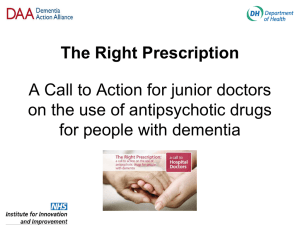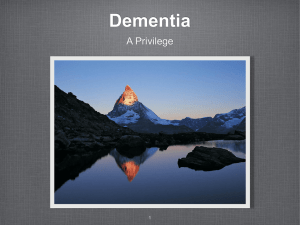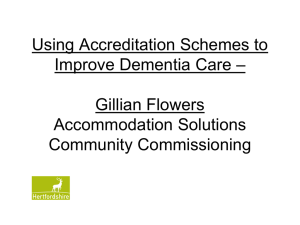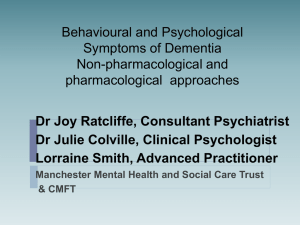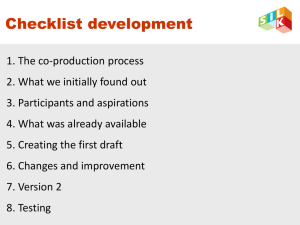Agitation - Ontario College of Family Physicians
advertisement
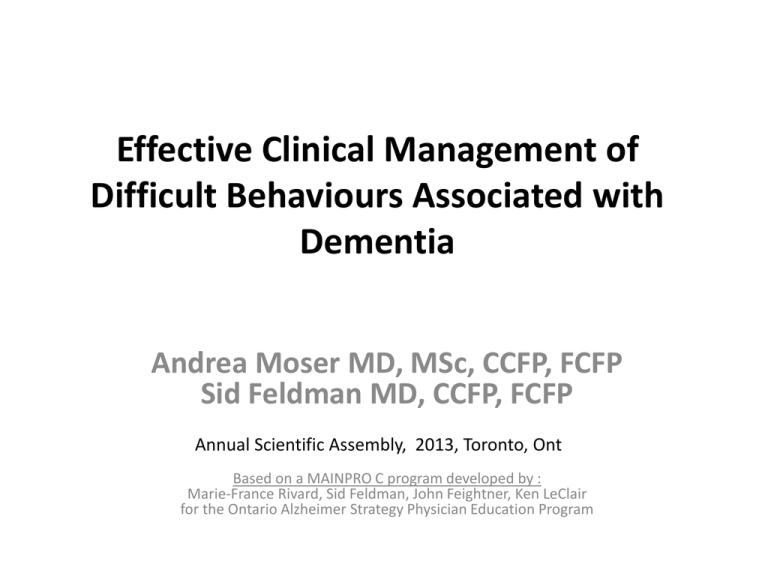
Effective Clinical Management of Difficult Behaviours Associated with Dementia Andrea Moser MD, MSc, CCFP, FCFP Sid Feldman MD, CCFP, FCFP Annual Scientific Assembly, 2013, Toronto, Ont Based on a MAINPRO C program developed by : Marie-France Rivard, Sid Feldman, John Feightner, Ken LeClair for the Ontario Alzheimer Strategy Physician Education Program Faculty/Presenter Disclosure • Faculty: Andrea Moser • Program: 51st Annual Scientific Assembly • Relationships with commercial interests: – Primary Care Advisory Board : Pfizer Canada Disclosure of Commercial Support • None • Potential for conflict(s) of interest: – Andrea Moser has received payment from Pfizer Canada whose product(s) are being discussed in this program Mitigating Potential Bias Will identify all Pfizer products when discussed during presentation Faculty/Presenter Disclosure • Faculty: Sid Feldman • Program: 51st Annual Scientific Assembly • Relationships with commercial interests: – Speakers Bureau/Honoraria: Amgen. Disclosure of Commercial Support • None • Potential for conflict(s) of interest: • None Mitigating Potential Bias • Not required Objectives • Have a framework for understanding BPSD • Be able to use the PIECES framework to formulate action plans for patients with BPSD • Be able to use behavioural symptom clusters to help guide treatment approaches • Be familiar with risks, benefits and appropriate dose range of medications that are recommended for BPSD What I would really like to know is: Overview Behaviour problems in dementia • Persons affected by dementia will react to the symptoms of their illness through observable behaviours. • Some behaviours are adaptive, others cause difficulties for the patient, the caregiver(s) or other person(s) the patient may interact with. Prevalence of BPSD • 90% of patients affected by dementia will experience Behavioural and Psychological Symptoms of Dementia (BPSD) that are severe enough to be labeled as a problem during the course of their illness. Impact of BPSD • 50 – 90% of caregivers considered physical aggression as the most serious problem they encountered and a factor leading to institutionalization (Rabins et al. 1982) • Front-line staff working in LTC report that physical assault contributes to significant work related stress (Wimo et al. 1997) Frequency of BPSD symptoms *More common in later stages of dementia Top Ten Behaviours not (usually) responsive to medication • Aimless wandering • Inappropriate urination /defecation • Inappropriate dressing /undressing • Annoying perseverative activities • Vocally repetitious behaviour • Hiding/hoarding • Pushing wheelchair bound co-patient • Eating in-edibles • Inappropriate isolation • Tugging at/ removal of restraints CCSMH National Guidelines 2006: www.ccsmh.ca • Assessment and treatment of mental health issues in long term care homes – Evaluate for medical conditions and diagnostic tests as indicated – Detailed interdisciplinary assessment for antecedents/causes – If BPSD does NOT pose imminent risk to patient or others – non-pharmacologic Rx Non-pharmacologic Approaches • PIECES* • Montessori methods • Gentle persuasive approach (GPA) *Focus today P.I.E.C.E.S. What is P.I.E.C.E.S.? • Person-centered assessment and care planning approach – Develop hypotheses and test the implementation of possible solutions. PIECES Physical Intellectual Emotional Capabilities Environment Social Each health discipline tends to be a bit “letter-centric” e.g. Physicians tend to be“P”-centric P PIECES Physical Intellectual Emotional Capabilities Environment Social P – Physical – Pain, discomfort – Bowels, bladder – Hunger, thirst – Delirium • • • • • Infectious Cardiovascular, respiratory, renal, etc… Metabolic Traumatic Toxins, Drugs I - Intellectual/cognitive changes • • • • • • • • • • Memory loss, Amnesia: Agnosia (Recognition of people or things) Apraxia Aphasia (speech) Anosognosia (Not knowing you don’t know) Impaired executive functions (planning) Return to a place back in time Apathy Perceptual difficulties Primitive reflexes, perseveration E - Emotions • Depressive symptoms – Withdrawal, crying, repetitive • Anxiety – Resistive behaviours • • • • Sun-downing Suspiciousness Delusions Psychosis C – Capabilities E - Environment • Capability too low to meet demands of environment – catastrophic reactions • or not utilized enough – boredom • Environment – Too noisy, confusing – Too quiet – Familiar vs unfamiliar settings S- Social interactions • Social, Spiritual – – – – – – Mountain Top Highs and Lows acknowledge accomplishments need to be useful likes and dislikes of the person cultural background Lifelong coping strategies less effective Mrs. Blake Mrs. Blake has moderately advanced Alzheimer type dementia. She requires assistance with dressing and toileting. • Each time she is taken to the bathroom, Mrs. Blake helps lower her pants but refuses to sit on the toilet. She resists and grabs her personal care attendants with such force that they are getting injured. Pharmacologic Approaches Top Ten Behaviors responsive (perhaps!) to medication • • • • Physical aggression Verbal aggression Anxious, restless Sadness, crying, anorexia • Withdrawn, apathetic • Sleep disturbance • Wandering with agitation/aggression • Vocally repetitious behavior due to depression or pain • Delusions and hallucinations • Sexually inappropriate behavior with agitation When to Consider Pharmacologic Treatment of BPSD? • Behavior is dangerous, distressing, disturbing, damaging to social relationships, persistent and may respond to treatment AND • Has not responded to comprehensive nonpharmacologic treatment plan including removal of possibly offending drugs. OR • Requires emergency treatment to allow proper investigation of underlying problems Decision framework for Pharmacological treatment • • • • • • Clear indication, potential benefits Expected time to response Risks associated with and without Rx Appropriate dose range Monitoring for side effects and response When to consider dose reduction, discontinuation. Clinical Assessment Tools • Daily Observation Sheet (DOS) Shows frequency, patterns of behaviours, individualized • Cohen Mansfield Agitation Inventory behaviours and severity over 7 day period • Kingston Standardized Behavioural Assessment (KSBA) Caregiver report of function, cognition and behaviour • MMSE, MOCA, Clock - cognitive • Confusion Assessment Method (CAM) Pharmacological treatment: Choosing best drug • Correct underlying cause: – Pain, acute illness, constipation, etc…. – Optimize treatment of dementia, CEIs, memantine • Target appropriate symptom cluster • Choose least likely to worsen dementia and medical problems – E.g. Least anticholinergic • Choose drugs without problematic interaction • Use one drug at time, monitoring effect on target symptoms BPSD Symptom Clusters Aggression Apathy Agitation Physical aggression Verbal Aggression Aggressive resistance to care; defensive Withdrawn Lacks interest Amotivation Pacing Repetitive actions Dressing/undressing Restless/anxious Euphoria Pressured speech Irritable Sad Tearful Hopeless Guilty Anxious Irritable/screaming Suicidal Depression Mania Hallucinations Delusions Misidentification Suspicious Psychosis Adapted from McShane R. Int Psychogeriatr 2000;12 (suppl 1):147 Pharmacologic Options • Dementia – Cognitive enhancers • Depressive symptoms – SSRI, SNRI – Match side effect profile with symptoms • Psychosis/distressing delusions – Atypical antipsychotics • Agitation – Choice depends on symptom and degree of risk Anxiety Symptoms • “Anxiety is NOT a benzodiazepine deficiency” Dr. Bill Dalziel, geriatrician • Cholinesterase inhibitor – particularly for anxiety of early dementia. • SSRIs – will take a few weeks to work – first line treatment for anxiety disorders – check drug interactions. • Consider trazodone (watch for hypotension) Antipsychotics: indications • Severe and persistent behavioral and psychological symptoms which are distressing to the patient or put the patient at risk and do not respond to non-pharmacological intervention • Acute management of delirium • Continuation of treatment of psychotic disorders that preceded the dementia Antipsychotic medications • Benefits: – Decrease suffering – Decrease risk of injury or exhaustion – May allow much needed medical investigations or interventions in acute delirium • Benefits of low dose atypical anti-psychotics may take up to 2 months… Antipsychotic medications • Risks and side effects: Hypotension - falls and fractures Over-sedation Anticholinergic side effects that can worsen cognition Weight gain and increased vascular risk factors may increase risk of CVA or worsen vascular or mixed dementia Parkinsonism (extra-pyramidal side effects affecting gait and posture, tremors, rigidity, excessive drooling) and tardive dyskinesia Increased mortality with all anti-psychotics (X2) • NO ideal anti-psychotic available at this time Antipsychotic medications • Strategies that minimize the risks to the patient. ▫ Baseline neuro, gait, BP assessment ▫ Use only if absolutely needed and only for as long as needed (e.g. days in delirium, months in severe BPSD) ▫ Chose drug that will be least likely to worsen medical problems of the patient ▫ Monitor closely for side effects ▫ Give it time to work before increasing the dose to toxic range… ▫ As soon as the symptoms appear to be under control, decrease the dose to avoid accumulation ▫ Review every 6 months if used for BPSD Antipsychotic medications • Strategies that minimize the medico-legal risks with anti-psychotics: ▫ Document consent discussion and target symptom ▫ Discuss risk/benefit with capable patient or substitute decision maker ▫ Review benefits and side effects you are watching for with family or SDM ▫ Document that you are reviewing regularly to try to decrease or discontinue. At minimum q 6 months ▫ Document non-pharmacological interventions used to reduce use of anti-psychotic medications Best choices: anti-psychotics • For acute delirium– very short term (days) – Haloperidol (0.5 mg that may be repeated) – Risperidone (0.25 mg that may be repeated) • For persistent psychosis/agitation – Risperidone (Risperdal) start with 0.25-0.5 mg daily and increase slowly as needed/tolerated over weeks to max. 2 mg per day – Olanzapine (Zyprexa): start with 2.5 mg daily and increase slowly as needed/tolerated over weeks, to max 10 mg daily – Quetiapine (Seroquel): start with 12.5 mg daily or BID and increase slowly over weeks to max 200 mg daily Approach to the Acutely Agitated Patient • Safety - of the patient, other residents and staff is number one concern • Assess competency - Except in an emergency the patient (if capable) or Substitute Decision Maker must be involved in treatment plan. • Treatment – of choice in urgent situations is oral atypical antipsychotics Urgent situations – Atypical Antipsychotics • M tab and Zydis are more quickly dissolved but do not have a more rapid onset of action • Time to peak plasma concentration: – risperidone = 1.5 hrs – olanzapine = 5 hrs – quetiapine = 1.5 hrs Summary Table: Meds for BPSD Target Symptoms Medication Starting Dose (mg/day) Average Target Dose (mg/day) Delusions Hallucination Aggression “Agitation” Atypical Antipsychotics: risperidone olanzapine quetiapine 0.25-0.5 2.5-5 12.5-25 0.5-2.0 2.5-7.5 50-400 Sadness Irritability Anxiety Insomnia Antidepressants citalopram sertraline venlafaxine mirtazapine trazodone 10 25 37.5 7.5 12.5-25 10-40 50-100 37.5-225 15-45 50-100 Summary Table: Meds for BPSD Target symptoms Medication Mood swings Euphoria Impulsivity Mood stabilizers: valproic acid carbamazepine Agitation Cholinesterase Inhibitors. Memantine Apathy Irritability Anxiety (short term use in predictable situations) Anxiolytics: lorazepam oxazepam Starting Dose (mg/day) Average Target Dose (mg/day) 250 50-100 500-1000 300-800 As directed As directed 5 mg daily 10 mg BID 0.25-0.5 5-10 0.5-1.5 10-30 Case Vignettes Case vignettes • Using the PIECES framework, develop hypotheses for why the behaviours are occurring and describe appropriate investigations you would consider. • How will you help the patient’s caregivers (at home or in the LTC)? Describe strategies that could be used to care for this person & minimize impact of the behaviours targeted. • If alterations are needed in medication, what should be done? Mr. Rose • Every day Mr. Rose remains in the same chair all morning until someone comes to get him for lunch. After lunch, he lingers in the dining area even after everyone has left. • His wife is annoyed that “he just sits there like a log” and never does anything! Mrs. Easy • Mrs. Easy was admitted to your ward 5 days ago. She looks upset and tells you that she finds that “the service is terrible”. • She wants to leave immediately. Mr. Klein • Mr. Klein comes out of his room inappropriately dressed. He has no shirt or undershirt. He has put his sweater on rather than a shirt and put his pajama top over his sweater. You can also see his pajama bottom sticking out of the bottom of his pants. He has just walked past one of other residents who shouted that he looked stupid and an altercation followed. Mr. Borden • Mr. Borden was admitted to hospital because he physically assaulted another resident of the Long Term Care home, where he resides. The dispute was over a toothbrush. • This morning, he is very upset because his glasses and wallet have been stolen and he demands that you call the police. Mr. Smith • Mr. Smith is admitted from the Nursing Home because he has tried to climb into bed with a female co-resident, while she was asleep. By the time the woman woke up, he had removed his pants and was caressing her inappropriately. She screamed and the nursing staff intervened. Mr. Noisy • Mr. Noisy has yet again got into trouble because he makes inappropriate comments to other residents and staff. He is insulting and provocative. This leads to verbal shouting matches and sometimes physical aggressive behavior. Unanswered Questions??? Contact information • Dr. Andrea Moser: – amoser@baycrest.org • Dr. Sid Feldman – sfeldman@baycrest.org P.I.E.C.E.S. tools • Daily Observation Sheet (DOS), • A-B-C charting – Shows frequency, severity, patterns of behaviors, can be individualized • Cohen Mansfield Agitation Inventory (CMAI) – Identifies behaviors and severity over 7 day period • Confusion Assessment Method (CAM) – Delirium screen • MMSE, MOCA, Clock • Sig: E Caps, Cornell Depression Scale DOS Behavior Map Time 6am 7am 8am 9am 10a 11a 12p 1pm 2pm 3pm 4pm MON TUE WED THU FRI SAT SUN Other Common Tools Scale Assessment CMAI 29 agitated behaviors rated by caregiver on 7 point frequency scale The Cohen-Mansfield Agitation Inventory 12 items rated by caregiver Neuro-psychiatric Inventory- on a 4 point frequency and a 3 point severity scale Nursing Home Version 25 symptoms rated by BEHAVE-AD The Behavioral Pathology in caregiver on a 4 point Alzheimer’s Disease Rating severity scale NPI-NH Scale Confusion Assessment Method for Delirium (CAM) Sensitivity 94-100%, Specificity 90-95% 1,2 AND 3 or 4 = Delirium 1. Acute onset and fluctuating course 2. Inattention AND 3. Disorganized thinking OR 4. Altered level of consciousness Inouye SK. Ann Int Med 1990 SIG: E CAPS (Rx for energy caps) • • • • • • • • • Sleep Interest Guilt : (colon...somatic complaints) Energy Concentration/Cognitive losses Appetite Psychomotor agitation/ retardation Suicide Caregiver Scales • Useful for patients in the community • Self report can be used in office setting or home visit • Allow caregivers to identify behaviours they may not be comfortable talking about in front of their loved one • i.e. - Kingston Behavioural Assessment Depression vs Dementia Features that Distinguish Depression from Dementia Primary Depression Primary Dementia Onset more acute and dated. Insidious onset, vaguely dated. Patient complains of cognitive deficits and seeks help. Unaware or no complaints of cognitive deficits. Patient complains in detail of memory. Vague complaints. Deficits are emphasized. Deficits are concealed. Patient makes little effort at task. Patient struggles with tasks. Attention is preserved. Faulty attention and concentration. “I don’t know” answers are typical. Frequent “near miss” answers. Variable performance. Consistently poor performance. Depression is often superimposed on dementia. Dementia assessment Nov 18,2010 Delirium vs Dementia CLINICAL FEATURES vs DEMENTIA CLINICAL DELIRIUM DEMENTIA Onset Course Consciousness Attention Hallucinations Sudden Fluctuating Reduced Disordered Often Present Insidious Stable Clear Normal Often Absent until Late in Course Often normal may see agitation late in course Psychomotor Activity Increased, Reduced or Shifting unpredictably **WITH A NEW BEHAVIOUR PROBLEM, FIRST RULE OUT DELIRIUM** Dementia assessment Nov 18,2010 Cognitive enhancers • Acetylcholinesterase inhibitors – Improving cognitive function or maintaining functional abilities – Improving socialization – Prevent decline in ADLs, decreasing amount of care needed – Postponing institutional care – Reducing behavioral and psychological symptoms (esp. in Lewy Body dementia) – Instilling hope and encouraging best use of remaining abilities? Cognitive enhancers • Side effects of donepezil, rivastigmine, galantamine: • Worsening of heart block leading to syncope, falls and fractures ▫ ▫ ▫ ▫ Asthma, COPD Peptic ulcers (esp. if taking other drugs) Seizures Drug interactions with Paroxetine, Fluoxetine, Fluvoxamine • Risks to monitor with use: ▫ ▫ ▫ ▫ ▫ Muscle cramps Insomnia and agitation Nausea and vomiting Diarrhea and Weight loss. Glutaminergic agent for moderate dementia • Memantine (Ebixa) • Indications: moderate to severe AD and vascular (or mixed) dementia • Benefits: cognition, socialization, ADLs and BPSD • Risks: confusion, headaches, agitation, insomnia, dizziness, urinary incontinence and UTIs. Hallucinations if dose too high. Do not use if severe renal impairment. Antidepressants: indications • Depression pre-existing or complicating dementia: Sig: E Caps, Cornell depression scale for depression in Dementia • Depressive and anxiety symptoms of frontaltemporal lobe dementia • Persistent anxiety symptoms leading to catastrophic reactions (e.g. vascular dementia) • Prevention of recurrent depressive episodes and anxiety disorders • Trazodone used for short-term sedation Best choices: antidepressants • SSRI for depression or anxiety – Citalopram (Celexa) and Escitalopram (Cipralex) – Sertraline (Zoloft) • Noradrenergic properties (pain, activation) – – – – Venlafaxine (Effexor XR) *not if unstable BP Desvenlafaxine (Pristiq) Duloxetine (Cymbalta) Bupropion (not if unstable BP) • Sedation may be needed – Trazodone *watch for hypotension – Mirtazapine (Remeron) * some anticholinergic properties and noradrenergic at higher doses Antidepressants: risks • • • • • • • Agitation and suicidal risk Headaches GI upset, diarrhea and bleeding ulcers Hyponatremia Over-sedation or insomnia QT prolongation Falls Pharmacological treatment: Expected time to response • Antidepressants for anxiety or depression: usually weeks • Trazodone used for sedation: short-lived but rapid response (repeat dose rather than increase HS dose) • Benzodiazepines: rapid response but multiple problems with chronic use • Antipsychotic Rx: – major tranquilizing effect within 2 hours with IM Haloperidol – Usually weeks with low dose oral atypical antipsychotic meds. Acute use unclear… Risks present when there is no pharmacological Rx • Risks of injury (self and others), exhaustion, severe and prolonged suffering, increased risk of death with depression, etc. • Need to present the risks of not treating with medications to pt or SDM when obtaining informed consent.


